Rangoli Design Trends: New ideas for celebrations
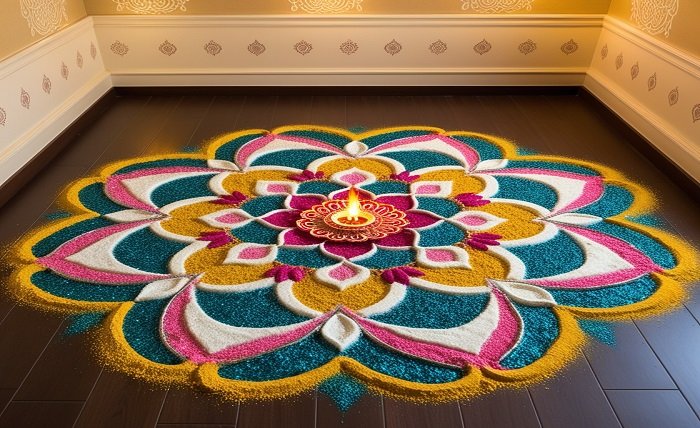
Indian rangoli designs, which are constructed with colorful powders, rice, and flower petals, are a beautiful and lively element of Indian culture. They are used to decorate homes, welcome guests, and celebrate holidays. These artistic creations have profound cultural and spiritual importance in addition to being a visual feast. We will explore the many facets of rangoli designs in this blog article, including their history, methods, and common themes. We will also cover how to make your own gorgeous rangoli.
The History and Significance of Rangoli
References to rangoli can be traced back to the Vedic era in ancient India. These patterns, which were originally called “kolam” in South India, were intended to bring luck and prosperity. They are typically built to greet guests and deities at a home’s entrance. Every design has a distinct meaning and frequently reflects spirituality, life, and nature-related themes.
Rangoli is a big deal during festivals like Diwali, Pongal, and Onam. Families join together to make intricate designs that add to the joyous atmosphere. Rangoli art has developed over time, embracing many materials and forms, but its fundamental goal of spreading happiness and positivism has not changed.
Rangoli Design Types
Customary Rangoli
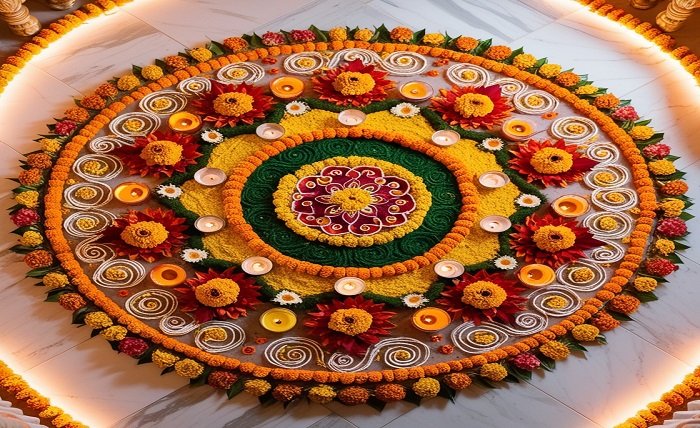
Traditional rangoli designs are often geometric and symmetrical, using natural materials like rice flour, turmeric, and colored powders. Common patterns include lotus flowers, peacocks, and mandalas. These designs are typically created using simple outlines and filled with vibrant colors. Traditional rangoli is not just about aesthetics; it also emphasizes the values of harmony and balance.
Contemporary Rangoli designs
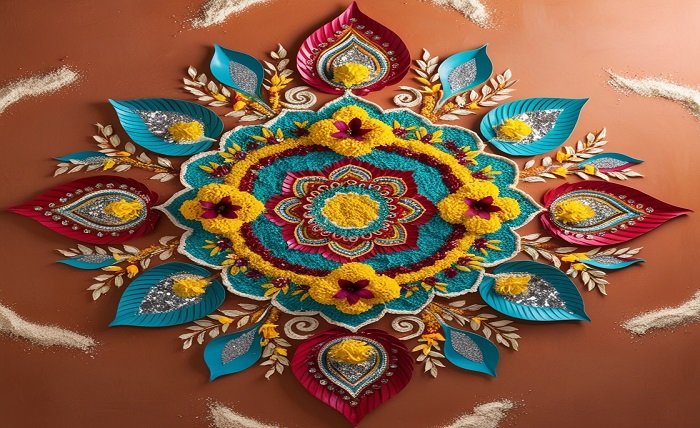
Contemporary art and design have influenced modern rangoli, leading to the adoption of novel forms and techniques. Abstract patterns, vivid color schemes, and avant-garde materials like glitter, beads, and synthetic powders are frequently used in these designs. Contemporary rangoli transcends traditional limits, promoting artistic expression while honoring its historical foundations.
3D Rangoli Designs
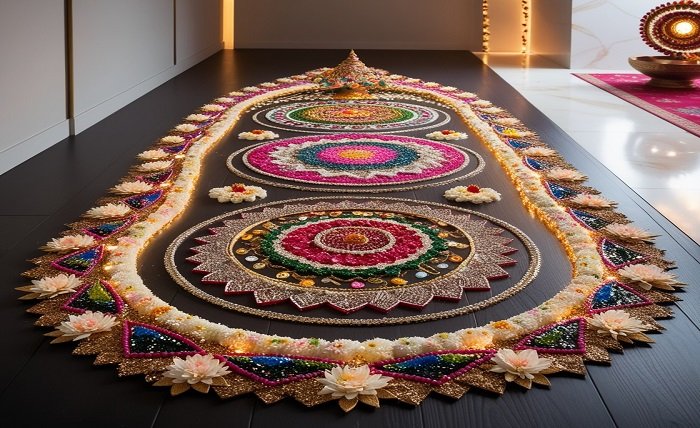
By using layers and shadow effects to create depth and perspective, 3D rangoli designs elevates the art form to a new level. To increase the visual impact, this style frequently uses mirrors, colored sand, and even flowers. Because of its dynamic look, 3D rangoli is becoming more and more popular for events and exhibitions.
Wall Rangoli versus Floor Rangoli
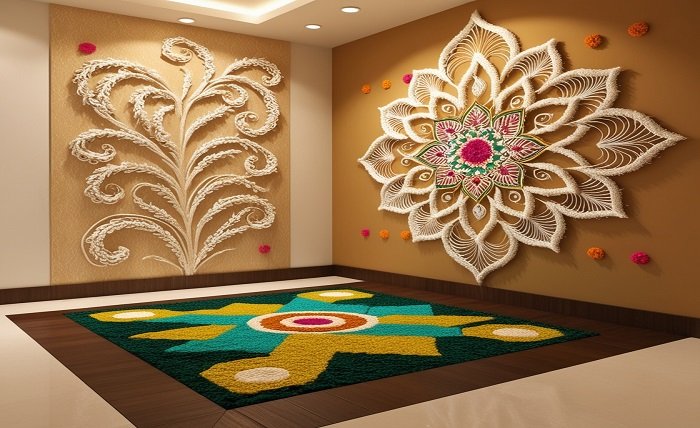
Wall rangoli has becoming more and more popular as a method of interior decoration, even though most rangoli designs are made on the floor. While wall rangoli can be permanent fixtures in homes, floor rangoli are more interactive and are frequently changed or washed away as the day goes on. Wall designs might utilize stencils or freehand techniques to create complex murals or more straightforward patterns.
Frequently Used Materials for Rangoli Designs

Beautiful rangoli require a variety of materials to create. Here are some common uses:
Various Colored Powders
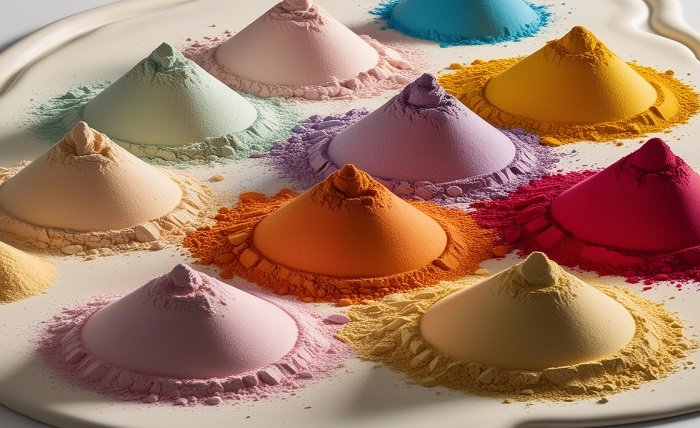
The main ingredient used to create rangoli patterns is colored powders. Sawdust, colored rice flour, or artificial coloring can be used to make these. The event frequently influences the color selection, with vibrant tones denoting happiness and celebration.
Petals of Flowers
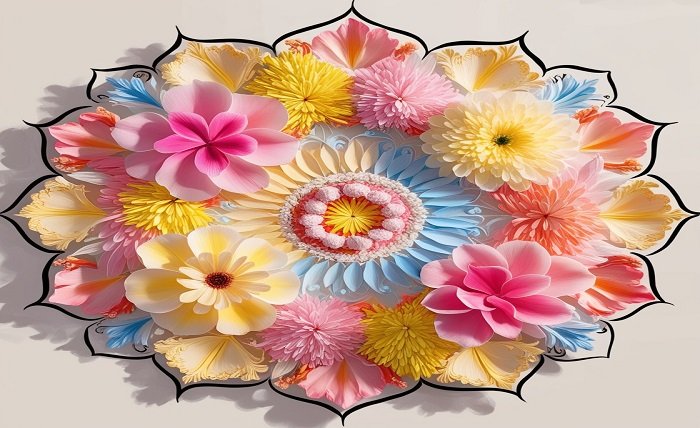
The use of fresh flower petals gives rangoli creations a touch of nature. They are frequently used with colored powders to make elaborate floral designs. Roses, jasmine, and marigolds are common floral arrangements.
Lentils with Rice
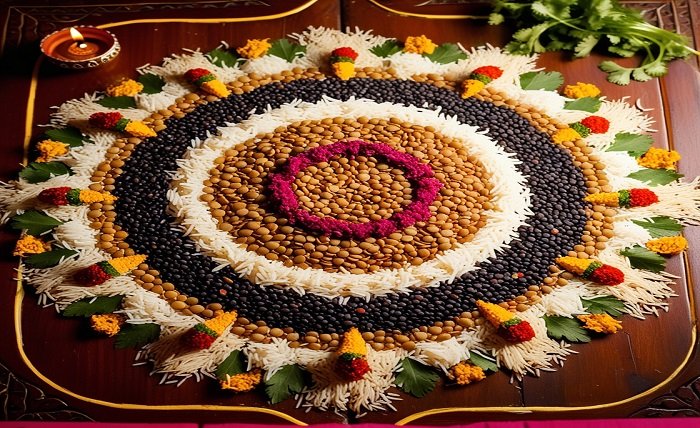
Lentils and rice are used to make designs in some areas. For a more rustic look, these materials are frequently left uncolored, highlighting the inherent white and brown tones.
Molds and Stencils
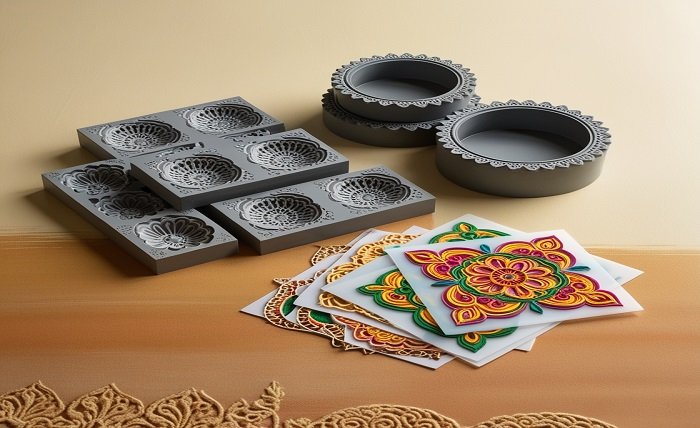
Molds and stencils can be used to make exact designs for people who aren’t sure they can draw by hand. These are easily reusable for a variety of purposes and can be constructed from cardboard, plastic, or metal.
Very Easy way to create your own Rangoli Designs
It might be satisfying to create a lovely rangoli design. Here’s a quick, step-by-step tutorial to get you started:
Select Your Design
Select the design of the pattern you wish to make. Choose from contemporary abstracts, classic patterns, or even three-dimensional components. Before starting, do a paper sketch of your design.
Ready Your Materials
Collect everything you’ll need, including rice, colored powders, flower petals, and any stencils or tools you want to use.
Clear the Space
Make sure the area is dry and clean before starting to create your rangoli designs will have a stronger base on a level surface.
Summarize Your Concept Of Designs
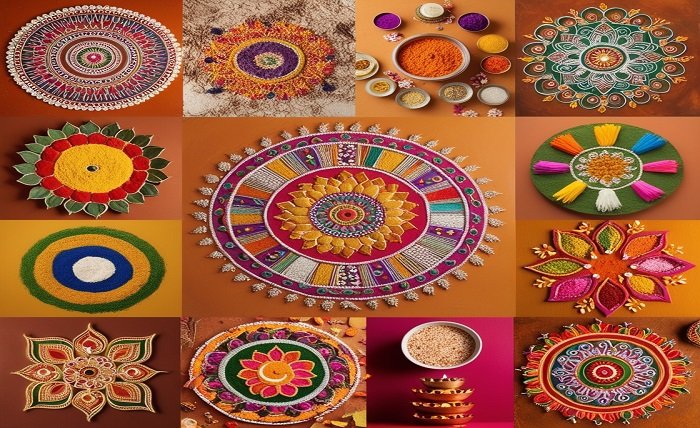
Outline your pattern on the surface with a piece of chalk or white powder. This will act as a blueprint for adding the color.
Choice the Colors
Depending on your design, begin filling in the colors by moving from the center outward or the other way around. Use your fingers or a tool to create good edges.
Include the last touches
Consider adding decorations, such as flower petals or glitter, to the main design once it has been completed to add texture and color.
Hope That,s You’ve Done!
Give your creation a moment of appreciation. Make sure you ask other people to admire it as well, if it’s for a big event!
Common Rangoli Designs and Their Interpretations
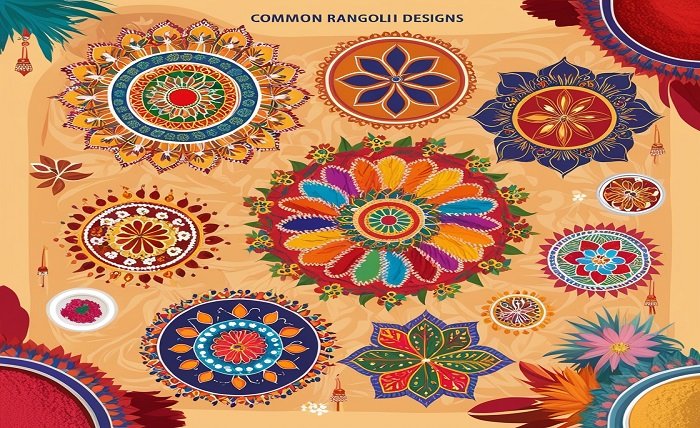
Gaining knowledge about the motifs frequently utilized in rangoli will enhance your experience. The following popular designs and their meanings are listed:
Lotus

The lotus flower is a symbol of purity and enlightenment in Indian culture. Incorporating this motif into your rangoli represents spiritual awakening and divine beauty.
Peacocks
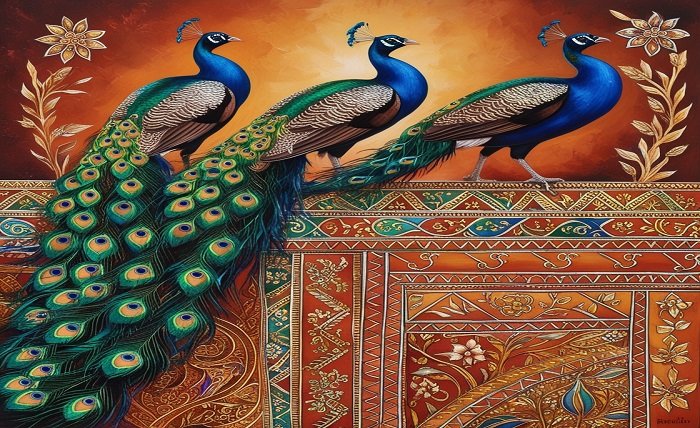
Peacocks are a symbol of elegance and grace. They are a popular choice during festive events because they are frequently used in rangoli designs to represent happiness and festivity.
Swastika
The swastika is an age-old symbol for prosperity and well-being that is frequently used into rangoli patterns to bring good fortune into the house.
Om
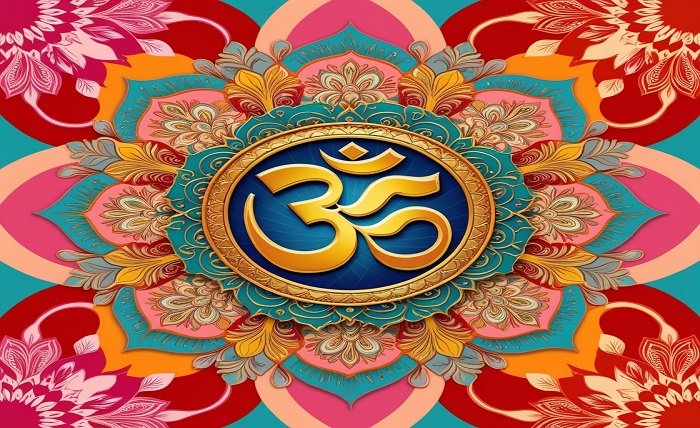
The Om symbol has spiritual significance in Hinduism. You can use it to bring calm and calmness into your room by including it into your rangoli designs .
Conclusion: The Art and Joy of Rangoli Designs
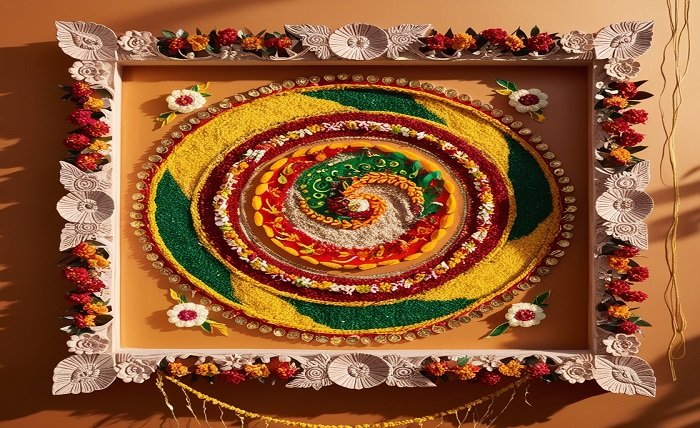
Rangoli designs are more than just decorative patterns; they embody cultural significance, creativity, and a sense of community. Whether you choose to create traditional designs or explore modern interpretations, the process of making rangoli can be a meditative and joyful experience. It allows you to express your artistic flair while connecting with the rich heritage of Indian culture.
You can appreciate rangoli art more deeply if you are aware of its history, types, and meanings. So gather your supplies, call on loved ones, and let the paints flow as you produce a magnificent work of art that brightens your days and makes you happy.
FAQ
What time of year is best for making rangoli designs?
Rangoli designs is usually made during festivals, particularly in the early stages of the festivities. It can, however, be created at any time to serve as a home décor piece.
Can I make rangoli with artificial colors?
Artificial coloring is acceptable, but you should make sure it’s safe and non-toxic, especially if kids or pets are present.
How do I clean up a rangoli design after an event?
With a broom, you can carefully remove the colored powders and flower petals. Think about composting any rice or lentils that you used.
Are there any specific rituals associated with rangoli?
Making rangoli is seen in certain cultures as a ritual to bring gods and good energy into the house, particularly during religious rituals.
Can one create rangoli indoors?
Absolutely, rangoli is a flexible type of decoration for any area since it can be made indoors as floor art or wall art.
Where can I find inspiration for rangoli designs?
Books, Pinterest, and other websites, as well as traditional styles seen in your neighborhood, can all serve as sources of inspiration. You may also find a ton of tutorials that walk you through particular patterns.
Because rangoli designs is a generation-spanning art form, it’s a lovely way to engage with creativity, culture, and community. The universe of rangoli art awaits your vibrant touch, regardless of your level of skill!
Latest Posts
